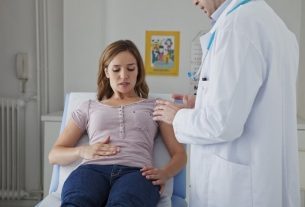The most characteristic symptom of HPV is the appearance of a wart in the genital region. This wart can appear around 3 to 10 months after infection with the virus and usually improves even if no other measures are taken.
Although they are most common in the genital region, warts can appear anywhere infected by the virus, including lips, cheeks, tongue, roof of the mouth or throat.
If HPV is suspected, it is important to consult a gynecologist, in the case of women, a general practitioner or urologist, for men, so that the most appropriate treatment can be initiated.

Common HPV Symptoms
The main symptoms of HPV include:
- Warts in the genital or anal region;
- Plaques formed by small warts;
- Warts on the lips, cheeks, tongue, roof of the mouth or throat;
- Discomfort at the site of the wart;
- Itching in the wart region.
Although, in most cases, HPV infection does not cause any further changes, there are some people who are unable to eliminate the virus from their body. This increases the risk of developing serious diseases such as cervical and penile cancer. Additionally, some types of HPV also have an increased risk of cancer.
HPV in women
HPV infection in women generally does not cause symptoms, but when present, it is common for warts to appear in the region of the vulva, labia majora, anus or cervix.
When HPV warts in women are not identified and treated appropriately, they can increase the risk of developing cervical cancer. Know how to recognize the symptoms of HPV in women.
HPV in men
HPV infection in men also does not usually cause symptoms. However, when symptoms are present, warts may appear on the head or body of the penis, scrotum and anus. See how to identify HPV in men.
Even if the warts are very small and cannot be seen with the naked eye, they can be identified through a peniscopy exam. Therefore, it is important to have regular visits to the urologist.
What to do in case of suspicion
In the case of suspected HPV infection, it is important that the person consults a urologist, gynecologist or general practitioner so that symptoms can be assessed and other tests can be recommended to help confirm HPV infection, such as penoscopy, in the case of for men, and pap smear followed by colposcopy for women.
In addition, tests may also be requested to identify the presence of antibodies circulating in the blood against HPV and more specific tests that help identify the virus and its quantity in the body. Find out more about the tests recommended for HPV.
HPV transmission
The transmission of HPV occurs through intimate contact with a person who carries the virus, even if that person does not present visible symptoms, whether through vaginal, oral or anal sex. HPV is highly infectious and, therefore, all it takes is contact with the skin or warts where the virus is present for infection to occur. Understand better how HPV is transmitted.
Furthermore, even though the use of condoms offers some protection against the transmission of HPV, infection can still occur through contact with unprotected areas during sexual intercourse, such as the vulva or scrotum.
How the treatment is carried out
HPV treatment may involve the application of medications such as podophyllin or trichloroacetic acid to the warts, cryotherapy with liquid nitrogen or surgery to remove lesions caused by the virus. The objective of the treatment is to eliminate warts caused by HPV and reduce the risk of transmission. It can be carried out by the person at home, according to the doctor’s instructions.
Furthermore, throughout the treatment it is important to avoid having sexual intercourse, even with a condom, as this can reduce the risk of transmitting HPV and acquiring other infections. Check out more details about HPV treatment.
Bibliography
- STRATTON, Kelly L; CULKIN, Daniel J. A Contemporary Review of HPV and Penile Cancer. Oncology (Williston Park). Vol.30, n.3. 245-249, 2016
- GRAVITT, Patti E; WINER, Rachel L . Natural History of HPV Infection across the Lifespan: Role of Viral Latency. Viruses. Vol.9, n.10. 267, 2017
- Comb, Aida et al. Non-sexual HPV transmission and role of vaccination for a better future (Review). Exp Ther Med. Vol.20, n.6. 186, 2020
- DUNNE, Eileen F; PARK, Ina U. HPV and HPV-associated diseases. Infect Dis Clin North Am. Vol.27, n.4. 765-778, 2013
- SNS24. Human papillomavirus (HPV). Available at: <https://www.sns24.gov.pt/tema/doencas-infecciosas/virus-do-papiloma-humano-hpv/#sec-1>. Accessed on January 20, 2021
- MINISTRY OF HEALTH. Practical guide on HPV – questions and answers. 2017. Available at: <https://portalarquivos2.saude.gov.br/images/pdf/2017/dezembro/07/Perguntas-e-respostas-HPV-.pdf>. Accessed on November 18, 2019
- MINISTRY OF HEALTH. HPV: what it is, causes, symptoms, treatment, diagnosis and prevention. Available at: <http://saude.gov.br/saude-de-az/hpv#tratamento>. Accessed on January 8, 2020
- SÃO PAULO MUNICIPAL STD/AIDS PROGRAM ASSISTANCE SECTOR OF THE SEXUALLY TRANSMITTED DISEASES CENTER. Guidelines for the diagnosis and treatment of HPV in the Municipal Network specialized in STD/AIDS. 2008. . Accessed on March 14, 2019
- DGS. Questions and answers about HPV. Available at: <https://www.saudereprodutiva.dgs.pt/paginas-intermedias/para-todos/pais-e-educadores/hpv-pais-e-educadores.aspx>. Accessed on January 20, 2021
- APF. Human Papilloma Virus – HPV. Available at: <http://www.apf.pt/infecoes-sexualmente-transmissiveis/virus-do-papiloma-humano-hpv>. Accessed on January 20, 2021
- PORTUGUESE LEAGUE AGAINST CANCER. What is HPV?. Available at: <https://www.hpv.pt/o-que-eo-hpv/>. Accessed on January 20, 2021
- CENTERS FOR DISEASE CONTROL AND PREVENTION. HPV and Men – Fact Sheet. Available at: <https://www.cdc.gov/std/hpv/stdfact-hpv-and-men.htm>. Accessed on Aug 1, 2019

Sign up for our newsletter and stay up to date with exclusive news
that can transform your routine!
Warning: Undefined array key "title" in /home/storelat/public_html/wp-content/plugins/link-whisper-premium/templates/frontend/related-posts.php on line 12
Warning: Undefined array key "title_tag" in /home/storelat/public_html/wp-content/plugins/link-whisper-premium/templates/frontend/related-posts.php on line 13




